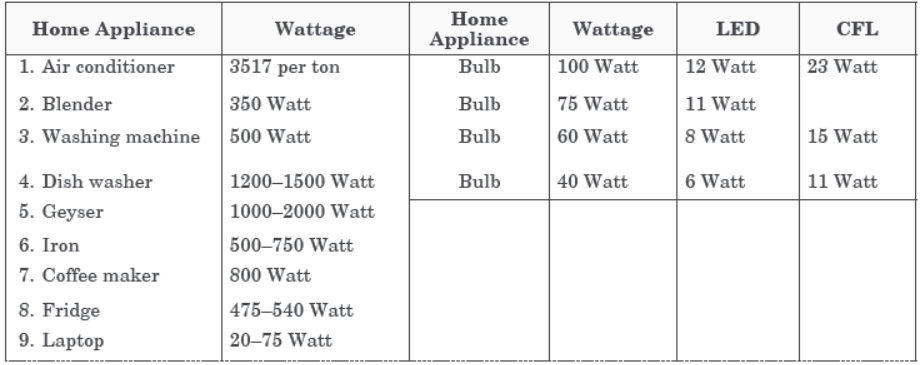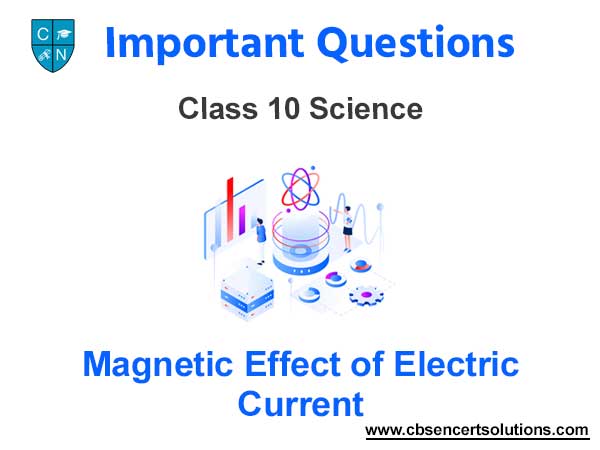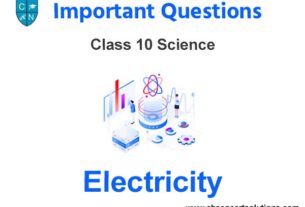Please refer to Chapter 13 Magnetic Effect Of Electric Current Case Study Questions with answers provided below. We have provided Case Study Questions for Class 10 Science for all chapters as per CBSE, NCERT and KVS examination guidelines. These case based questions are expected to come in your exams this year. Please practise these case study based Class 10 Science Questions and answers to get more marks in examinations.
Case Study Questions Chapter 13 Magnetic Effect Of Electric Current
Case/Passage – 1
A solenoid is a long helical coil of wire through which a current is run in order to create a magnetic field. The magnetic field of the solenoid is the superposition of the fields due to the current through each coil. It is nearly uniform inside the solenoid and close to zero outside and is similar to the field of a bar magnet having a north pole at one end and a south pole at the other depending upon the direction of current flow. The magnetic field produced in the solenoid is dependent on a few factors such as, the current in the coil, number of turns per unit length etc. The following graph is obtained by a researcher while doing an experiment to see the variation of the magnetic fieldwith respect to the current in the solenoid. The unit of magnetic field as given in the graph attached is in milli-Tesla (mT) and the current is given in Ampere.

Question: What will happen if a soft iron bar is placed inside the solenoid?
(a) The bar will be electrocuted resulting in shortcircuit.
(b) The bar will be magnetised as long as there is current in the circuit.
(c) The bar will be magnetised permanently.
(d) The bar will not be affected by any means.
Answer
B
Question: From the graph deduce which of the following statements is correct.
(a) For a current of 0.8A the magnetic field is 13 mT
(b) For larger currents, the magnetic field increases nonlinearly.
(c) For a current of 0.8A the magnetic field is 1.3 mT
(d) There is not enough information to find the magnetic
field corresponding to 0.8A current.
Answer
A
Question: The magnetic field lines produced inside the solenoid are similar to that of …
(a) a bar magnet 10
(b) a straight current carrying conductor
(c) a circular current carrying loop
(d) electromagnet of any shape
Answer
A
Question: What type of energy conversion is observed in a linear solenoid?
(a) Mechanical to Magnetic
(b) Electrical to Magnetic
(c) Electrical to Mechanical
(d) Magnetic to Mechanical
Answer
C
Question: After analysing the graph a student writes the following statements.
I. The magnetic field produced by the solenoid is inversely proportional to the current.
II. The magnetic field produced by the solenoid is directly proportional to the current.
III. The magnetic field produced by the solenoid is directly proportional to square of the current.
IV. The magnetic field produced by the solenoid is independent of the current.
Choose from the following which of the following would be the correct statement(s).
(a) Only IV
(b) I and III and IV
(c) I and II
(d) Only II
Answer
D
Case/Passage – 2
For a conductor of length L carrying a current of I in a field B the force experienced by the conductor F→= I L→ x→ B If the current-carrying conductor in the form of a loop of any arbitrary shape is placed in a uniform field, then, F→ =0 i.e., the net magnetic force on a current loop in a uniform magnetic field is always zero. Here it must be kept in mind that in this situation different parts of the loop may experience elemental force due to which the loop may be under tension or may experience a torque.
Direction of force can be determined by fleming’s left hand rule, right hand palm rule or screw rule.
Question: An electron moving with uniform velocity in x-direction enters a region of uniform magnetic field along y-direction. Which of the following physical quantity(ies) is (are) non-zero and remain constant?

I. Velocity of the electron
II. Magnitude of the momentum of the electron.
III. Force on the electron.
IV. The kinetic energy of electron.
(a) Only I andII.
(b) Only III and IV.
(c) All four
(d) Only II and IV.
Answer
D
Question: A wire is lying horizontally in the north-south direction
and there is a horizontal magnetic field pointing towards and the east. Some positive charges in the wire move north and an equal number of negative charges move south. The direction of force on the wire will be

(a) east
(b) down, into the page
(c) up, out of the page
(d) west
Answer
B
Question: Which of the following can produce a magnetic field?
(a) Electric charges at rest
(b) Electric charges in motion
(c) Only by permanent magnets
(d) Electric charges whether at rest or in motion
Answer
B
Question: The direction of induced current is obtained by
(a) Fleming’s left hand rule
(b) Maxwell’s cork-screw rule
(c) Ampere’s rule
(d) Fleming’s right hand rule
Answer
D
Question: Four situations are given below-
I. An infinitely long wire carrying current
II. A rectangular loop carrying current
III. A solenoid of finite length carrying current
IV. A circular loop carrying current.
In which of the above cases will the magnetic field produced be like that of a bar magnet?
(a) I
(b) I and III
(c) Only III
(d) Only IV
Answer
C
Case/Passage – 3
The strength of the magnetic field produced by a currentcarrying circular coil (or circular wire) depends on (i) Current flowing through the coil. (ii) Radius of the circular coil. (iii) Number of turns of wire in the circular coil.
Question: What type of curve we get, between magnetic field and distance along the axis of a current carrying circular coil?
(a) Straight
(b) Circular
(c) Parabolic
(d) None of these
Answer
D
Question:A long horizontal power line is carrying a current of 100 A in the east-west direction. The direction of magnetic field at a point 1.0 m below it is
(a) south to north
(b) north to south
(c) east to west
(d) west to east
Answer
B
Question: If a current carrying straight conductor is placed is east-west direction, then the direction of the force experienced by the conductor due to earth’s magnetic field is:
(a) downward
(b) upward
(c) east-west
(d) west east
Answer
A
Case/Passage – 4
Study this table related to wattage of home appliances and answer the questions that follow.


Question. Which of the following will to consume least power?
(a) Laptop
(b) Desktop
(c) Printer
(d) Blender
Answer
A
Question. Many appliance works on the principle of electromagnetic induction. The role which depicts the direction of induced current is as
(a) Faraday’s rule
(b) Henery’s rule
(c) Fleming’s rule
(d) Maxwell’s rule
Answer
C
Question. Which of the following home applicance is not based on magnetic effect of current?
(a) Ceiling fan
(b) Blender
(c) Geyser
(d) Washing Machine
Answer
C
Question. Which of the following will consume maximum power?
(a) Fridge
(b) Iron
(c) Air conditioner
(d) Coffee maker
Answer
C
Question. Which of the following lighting device is best to use in terms of power consumption?
(a) Bulb
(b) CFL
(c) Tube light
(d) LED
Answer
D
Case/Passage – 5
A magnetic stripe card, also referred to as a swipe card or magstripe, is a plastic card with a magnetic strip attached on its surface. This stripe is made of tiny iron-based components whose magnetism can be modified and can therefore be used to store information. A magstripe is quite similar to a magnetic recording tape, which you might find in videotape or a music cassette. The magnetic strip on a card can be ‘written’ or encoded with information because the tiny iron-based particles that make up the strip can be magnetised in different directions by a device that produces a strong magnetic field. This device is a ‘solenoid’, which is basically a coil wound into a tightly packed helix. The wire is wound around a highpermeable, metallic core that produces a strong magnetic field when a current is passed through it. This device encodes the required information onto the stripe, which is then pasted on a plastic card. When a card with a magnetic strip is moved back and forth over the ‘reader head’ , a voltage is induced in the coils of the card reader device. A card reader consists of solenoid too – the same component that is used to write information in the magnetic strip.
This voltage can be amplified and recorded electronically, which is finally read by a computer (or a processor installed within the reader) to authenticate a user (in the case of identity cards) or a transaction (in the case of credit/debit cards).
Question. The force on a wire inside a magnetic field increase when
(a) The current is increased
(b) Strength of magnetic field increases
(c) Length of wire is increased
(d) All of above
Answer
D
Question. The factors on which one magnetic field strength produced by current carrying solenoids depends are
(a) Magnitude of current
(b) Number of turns
(c) Heat produced
(d) Both (a) and (b)
Answer
D
Question. Which of the following are the devices that uses magnetic theory to record data
(a) The hotel key cards
(b) Audio tapes
(c) CD’s
(d) All of the above
Answer
D
Question. The information of users which are read by the ATM machines are stored on
(a) Magnetic box on card
(b) Magnetic strip on card
(c) Inside ATM machine
(d) None of above
Answer
B
Question. Name the scientist who gave the principle of electromagnetic field
(a) Oersted
(b) Faraday
(c) Bohr
(d) Ampere
Answer
A



